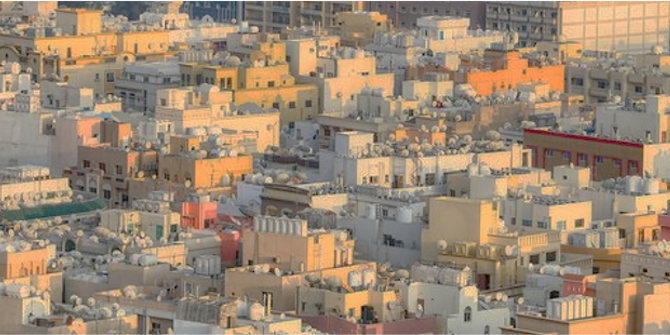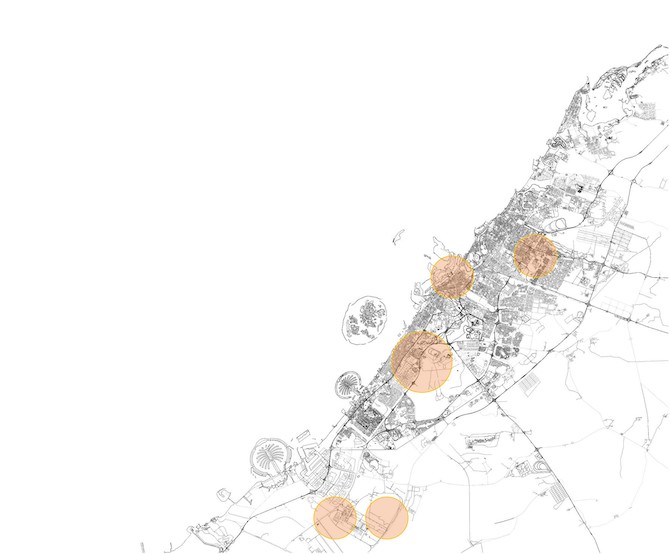 A typical neighbourhood in Dubai. Source: Google Images
A typical neighbourhood in Dubai. Source: Google Images
There are great attention ongoing on Dubai.. Dubaization, as many would call.. The city that emerged from the sand dunes to be one of the top worldly megacities within less than 25 years.. Yet; many observers mistakenly analyze what is happening within the tiny City-State context..!!
Metropolisation and Spatial Segregation in Gulf Cities:
The Case of Dubai
Since antiquity, Bedouin cities have always been influenced by sedentary culture, which has underpinned the social sustainability of tribes per se. The traditionalist ‘compact-city’ planning had high density urban structures with mixed land uses. Cities like Abu Dhabi, Dubai & Kuwait City have seen an expeditious transition in the last 50 years. They have become highly car-dependent, exclusionary in nature and their planning and development patterns have been largely shaped for a certain class. The critical intersection of urbanisation and economic development often leaves behind the traditional purpose of streets (making social connections). While over time, mass migration has brought about de facto cosmopolitanism in Arabian cities, especially Abu Dhabi & Dubai; foreign residents continue to experience segregation. The idea of putting a modernist urban grid into an Arab context has had various implications on social life. The dead building facades & obstructing boundary walls of houses that limits ‘eyes on the street’, in addition to segregated land use zoning, a lack of pedestrian-centric infrastructure, and dependence on motorised transport, have painted a car-centric image of Abu Dhabi’s public life. Howbeit, the average superblock size is 900×600m, which has high potential for more accessible and effective street use. In a general sense, spatial segregation intensifies social segregation. Streets, being the most critical unit of a neighbourhood, can be used to include or exclude communities. This dimension requires particular attention, and is addressed here through the empirical study of Deira, a neighbourhood in Dubai. The assessment revealed that various characteristics relating to urban form, such as built-up density, land use, mobility, streets layouts, built environment’s safety and aesthetic qualities, are the main factors undermining social sustainability in the studied locality. The results informed a set of suggested regeneration strategies for the neighbourhoods. These include increasing the built-up density by redevelopment, vertical mixing of land use to achieve diversity in housing types and access to public transport.
It is essential to understand the critical intersection of urbanisation and economic development in growing economies. After the 1970s, the emergence of the oil industry precipitated a notable rise in demand for labour. In order to fulfil this, the Kafala system was established. It promoted the rapid influx of migrant labourers (both skilled & non-skilled) largely from South Asia. As a consequence, Emirati cities witnessed the emergence of a hierarchical society where locals were part of a privileged social category, while migrants occupied the lowest strata. This form of otherisation has aggravated social inequalities and segregation.

Morphology has long been a useful tool for understanding and analysing affordability and diversity. Research studies on the morphological evolution of cities have focused primarily on more established societies with longer histories. Spatial analysis of urban form has not been historically contextualised when it comes to the UAE or Gulf region. To select the case study, a few parameters were taken into consideration, including: housing type, rent pricing, access to public transport and other urban services. There are currently seven different types of housing: organically dense, tower complexes & waterfronts, island & off-shore communities, apartment complexes, midrise labour colonies, gated communities & single-family apartments.

















R.I.P.
So what ?
I have just finished reading (again) Royce's "Managing the development of large software systems".
It is about software development
just like the Agile Manifesto
It says "it is important to involve the customer"
just like the Agile Manifesto
It says "To give the contractor free rein between requirement definition and operation is inviting trouble"
just the opposite of the Tunnel Effect, one of the key points waterfall is blamed for
It says "there is an iteration with the preceding and succeeding steps", which is against the so-called waterfall
It is about large systems - just like agile at scale
It is about Risk Management - oh yeah !
It was written 50 (yes: five zero) years ago !
We could go further this way.
Waterfall does not exist.
Agile does not exist.
Can we stop opposing them ?
The Agile Manifesto is a summary of Royce's paper.
Agile mindset could be applied to any type of project - in fact, it was the case from the beginning as the debate exists only in the IT world.
Any points ? Of course !
Talking about agility brings new names to old concepts, and refreshes them to make them fashionable again and again !
Stop arguing, start leading your projects !